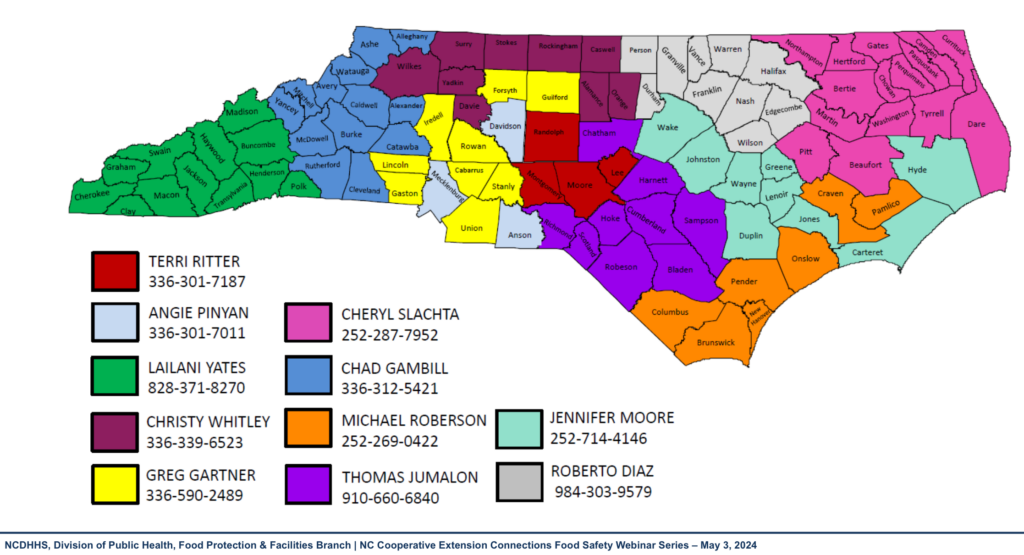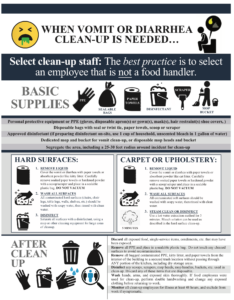NC DHHS: Food Protection Program
go.ncsu.edu/readext?1002537
en Español / em Português
El inglés es el idioma de control de esta página. En la medida en que haya algún conflicto entre la traducción al inglés y la traducción, el inglés prevalece.
Al hacer clic en el enlace de traducción se activa un servicio de traducción gratuito para convertir la página al español. Al igual que con cualquier traducción por Internet, la conversión no es sensible al contexto y puede que no traduzca el texto en su significado original. NC State Extension no garantiza la exactitud del texto traducido. Por favor, tenga en cuenta que algunas aplicaciones y/o servicios pueden no funcionar como se espera cuando se traducen.
Português
Inglês é o idioma de controle desta página. Na medida que haja algum conflito entre o texto original em Inglês e a tradução, o Inglês prevalece.
Ao clicar no link de tradução, um serviço gratuito de tradução será ativado para converter a página para o Português. Como em qualquer tradução pela internet, a conversão não é sensivel ao contexto e pode não ocorrer a tradução para o significado orginal. O serviço de Extensão da Carolina do Norte (NC State Extension) não garante a exatidão do texto traduzido. Por favor, observe que algumas funções ou serviços podem não funcionar como esperado após a tradução.
English
English is the controlling language of this page. To the extent there is any conflict between the English text and the translation, English controls.
Clicking on the translation link activates a free translation service to convert the page to Spanish. As with any Internet translation, the conversion is not context-sensitive and may not translate the text to its original meaning. NC State Extension does not guarantee the accuracy of the translated text. Please note that some applications and/or services may not function as expected when translated.
Collapse ▲The mission of the Food Protection Program is to reduce the risk of food-borne illness and other communicable diseases by ensuring reasonable protection by providing progressive leadership, resources, and education for the promotion of public health, safety and confidence for the people.
Webinar Highlights
Entities under Food Protection and Facilities Branch
- Food service establishments – restaurants, buffets, food stands, mobile food trucks, and push carts
- Meat markets
- Lodging and Bed & Breakfasts (Air BnB is not included in this category)
- Institutions
- Camps – residential, summer and primitive
- Adult Day Services
- Local Confiment
- Residential Care Homes
North Carolina Rules
This Division finds their rules outlined in NC General statute 130A-248, namely, the .2600 Rules. Within, we see rules that include:
The North Carolina Food Code:
- Newest version became effective on October 1, 2021
- Requires legislative approval
Public display of Grade Cards
- Must be easily seen by the public, or location agreed upon between DHHS & facility
- Must be displayed at all times
- Includes food served on a mobile food unit or push cart
- Includes grading:
- At least 90% = Grade A
- At least 80 and less than 90% = Grade B
- At least 70% and less than 80% = Grade C
- Lower than 70% = immediate revocation
The North Carolina Food Code Annex
Provides supporting information to the Food Code, including:
- Why the provision exists
- Why the provision is important
- The science behind the provision
Examples of information found in the Annexes:
- Guidances and Position Statements
- No bare hand contact with ready-to-eat foods
- Time and temperature parameters for cooking, holding, cooling and reheating
- Consumer advisory statements for consumption of raw or undercooked products
- Variance information for high-risk food processes such as: reduced oxygen packaging or fermentation
- Annex 1: Compliance and Enforcement
- Annex 2: References
- Annex 3: Public Health Resources
- Annex 4: Management of Food Safety Practices
- Annex 5: Conducting Risk-Based Inspections
- Annex 6: Food Processing Criteria
- Annex 7: Model Forms, Guides and other Aids’
Foodborne Illness Risk Factors
- Improper holding temperatures
- Inadequate cooking
- Contaminated equipment
- Unsafe sources of food
- Poor personal hygiene
Food Code Interventions
- Management must demonstrate food safety knowledge
- Utilize employee health controls
- Controlling hands as a vehicle of contamination
- Time & temperature parameters for controlling pathogens
- Consumer advisories
2021 Food Code Highlights & Updates
Time and Temperature Control for safety foods
- Used to identify foods that require cold holding or hot holding during storage and/or display
- Will no longer see terminology ‘potentially hazardous food’
Certified Food Protection Manager
- The person in charge must be a certified food protection manager who has passed a test through an accredited program
- North Carolina DHHS has created a Demonstration of Knowledge Checklist that can help establishments be prepared for food safety conversations with their regulators.
- More information on NC State Extension’s Safe Plates Programs
Reportable Diagnosis
- Now reporting the ‘Big 6 Diseases’
- Norovirus
- Hepatitis A
- Shigella spp.
- Shiga-toxin producing Escherichia coli
- Salmonella typhi
- NEW! Salmonella (nontyphoidal)
- North Carolina DHHS has created a Food Employee Reporting Agreement that can help establishments start conversation about illnesses with their employees.
Clean-up of Vomiting and Diarrheal Events
- Must have written procedures for clean-up
- Goal is to minimize contamination and exposure to employees, consumers and foods
- North Carolina DHHS has created a written procedure template that can help establishments develop customized and effective procedures for these events
- Click on image to enlarge and/or download
Inspection Frequency
- Risk Category IV facilities should expect inspections three times each year (previously once every quarter), AND
- Will also include an educational visit each fiscal year
- Educational visits will typically focus on high-risk procedures and foods as well as any prior priority violations
Mobile & Temporary Food Service Units
- A temporary food establishment will be able to operate in one location for no more than 30-days, a one-time 15-day extension is possible
- Must also operate in conjunction with events listed in limited food service establishments as listed in G.S. 130-A-247(8)
- Establishment can not provide customer seating
- Must provide County Health with locations of operation so they can be regulated
- Push carts can only be utilized to serve hot dogs and pre-wrapped foods
Non-profit Fundraisers
- Must be an established non-profit organization
- Can vend foods for 2 consecutive days each month
- Should reach out to the County Health Department in the county the event is being held in
Department of Health & Human Services, Food Protection Program Contacts
| Cheryl Slachta, REHS | Environmental Health Regional Specialist (Eastern Region) | Cheryl.Slachta@dhhs.nc.gov | (252) 287-7952 |
| Food Protection Program | Main Office, Raleigh | EHS Website | (919) 707-5854 |
Webinar hosted on May 3, 2024
![]() “This work was supported by the intramural research program of the U.S. Department of Agriculture, National Institute of Food and Agriculture, Food Safety Outreach Program 1030908. The findings and conclusions in this preliminary publication have not been formally disseminated by the US Department of Agriculture and should not be construed to represent any agency determination or policy.”
“This work was supported by the intramural research program of the U.S. Department of Agriculture, National Institute of Food and Agriculture, Food Safety Outreach Program 1030908. The findings and conclusions in this preliminary publication have not been formally disseminated by the US Department of Agriculture and should not be construed to represent any agency determination or policy.”




